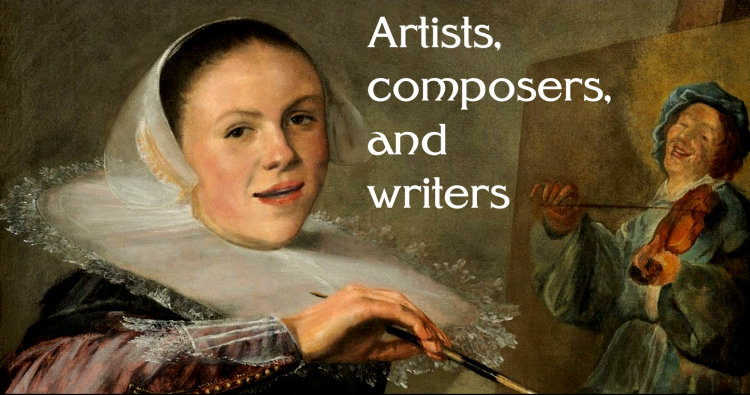4. The Art of Transcendence.
By the peak of the Seventeenth Century, the baroque style could be described as an international phenomenon,
dominating the monumental commissions of Church and State, and extending even into the Americas. It is the art
of transcendence, sweeping away normal boundaries and transporting its audience to other world of the imagination.
But it had its origin quite specifically in Italy, especially in the kind of illusionistic painting and sculpture
that could transform entire buildings. This will be the subject of our first hour.
In the second hour, we shall look at three specific examples of the transmission of the baroque style to other
countries. Rubens, one of the great geniuses of the age, moving freely from court to court. Velázquez working mainly
in Spain, and seldom on a monumental scale, but pursuing his own unique inventions. And one other Italian, Caravaggio,
whose realism and drama offered a distinct alternative to the prevalent style, and whose influence proved especially
important in the development of Dutch art.
The script, videos, and images will be posted immediately after class.
Here are brief bios of the artists and poets considered in the class, listed in chronological order of birth.
You can access all biographies via the BIOS link on the syllabus page.
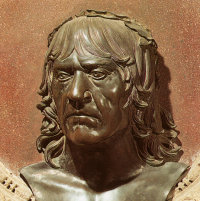 |
Andrea Mantegna, 1431–1506. Italian painter.
Mantegna's work is characterised by formidable skills in drawing and color, passionate interest in classical antiquity, formal invention, and frequent sparks of wit. He spent the last 45 years of his life as court painter to the ruling Gonzaga family in Mantua, and all of these qualities show up in his painted decoration of the Camera degli sposi in the ducal palace.
|
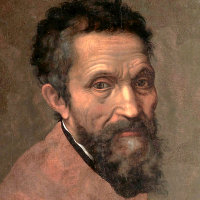 |
Michelangelo Buonarroti, 1475–1564. Florentine sculptor, architect, painter, and poet.
A towering universal genius, his work virtually defines the Italian High Renaissance. He made his name primarily as a sculptor in his native Florence, though he worked elsewhere as well. His most famous works, however, are in Rome: the ceiling of the Sistine Chapel (1508–12) and his work from 1546 as leading architect of the Basilica of St. Peters, one of a succession of masters who brought the building to its present form.
|
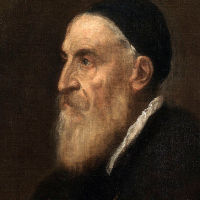 |
Tiziano Vecellio (Titian), 1485–1576. Venetian painter.
Arguably the greatest Venetian painter of the High Renaissance, he produced works in just about every genre over an exceptionally long career. Probably his greatest influence was in his handling of paint and use of color, which became a starting point for Rubens and others in the next century.
|
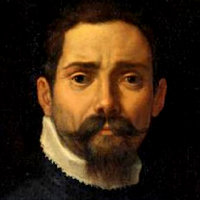 |
Giovanni Gabrieli, 1557–1612. Italian composer.
Third in a line of succession to Adrien Willaert and his uncle Andrea Gabrieli as organist of Saint Mark's in Venice, he is famous for the spatial effect of his polychoral compositions, using mixed groups of instruments and voices calling to one another antiphonally between the various balconies of the church.
|
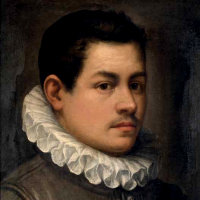 |
Annibale Carracci, 1560–1609. Italian painter.
He was the youngest of the three Carracci artists (brother Agostino b.1557, cousin Lodvico b.1555) who often collaborated. Annibale was the principal designer of the mythological themes for the Palazzo Fava in Bologna (c.1584) and the celebrated Palazzo Farnese in Rome (c.1600).
|
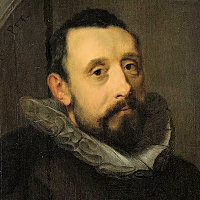 |
Jan Pieterszoon Sweelinck, 1562–1621. Dutch composer.
As organist of the Old Church in Amsterdam and a sought-after teacher, he had immense influence on later generations of Northern European organist-composers. He was the first to give an independent part to the organ pedals, and to write fully worked-out fugues.
|
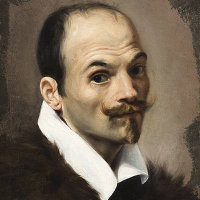 |
Orazio Gentileschi, 1563–1639. Italian painter.
One of the few Italian followers of Caravaggio who were friends with the master, he traveled widely and was important in spreading knowledge of his style, athough his own painting became lighter and more colorful in his later years. He was the father and teacher of Artemisia Gentileschi.
|
 |
Claudio Monteverdi, 1567–1643. Italian composer.
The towering genius of the first half of the 17th century, and a founding father of opera. Unfortunately, only three of his dozen operas survive: La favola di Orfeo (The Story of Orpheus), written for Mantua in 1607 and the earliest opera to remain in the general repertoire, and The Return of Ulysses and The Coronation of Poppea, both written for Venice at the end of his life.
|
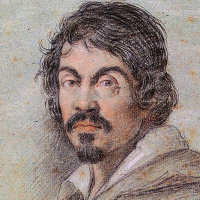 |
Michelangelo Merisi da Caravaggio, 1571–1610. Italian painter.
Arguably the most original Italian painter at the start of the 17th century, he treated mostly religious subjects in a bold realist style that shocked his contemporaries, but was nonetheless widely influential. His figures tend to be large in proportion to the canvas, their actions and reactions dramatic, and their appearance that of ordinary working people. Caravaggio also often used concealed light sources that increases the drama of his depictions.
|
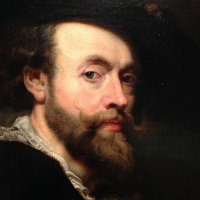 |
Peter Paul Rubens, 1577–1640. Flemish painter and diplomat.
One of the giants of baroque art, Rubens developed the style of Titian into a powerful rhetoric applied equally to sacred and profane subjects, and exerted enormous influence in Spain, England, and France as well as in his native Flanders, continued in the work of his many pupils. His position at so many courts also made him invaluable as a diplomat.
|
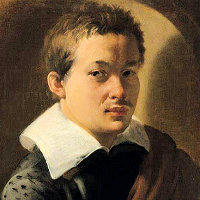 |
Hendrick Terbrugghen, 1588–1629. Dutch painter.
He was a leading member (with Honthorst and Baburen) of the Utrecht School of painters in early 17th-century Holland, following in the style of Caravaggio. Among them, Terbrugghen is noted for his gentler tonal gradations and subtlety of color. Also spelled "Ter Brugghen."
|
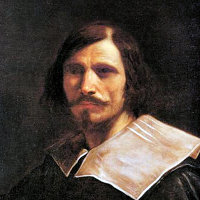 |
Guercino (Giovanni Francesco Barbieri), 1591–1666. Italian painter.
His crossed eyes, which earned him the nickname "Guercino" (squinty), did not prevent Barbieri from becoming one of the principal Italian painters of religious and mythological works in the early baroque, including the ceiling fresco The Triumph of Aurora (1621) in the Casino Ludovisi in Rome.
|
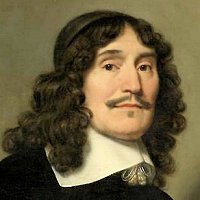 |
Gerrit van Honthorst, 1592–1656. Dutch painter.
He was a leading member (with Terbrugghen and Baburen) of the Utrecht School of painters in early 17th-century Holland, following in the style of Caravaggio. His earlier works are noted for his use of a candle (often semi-concealed) to provide the ostensible light for his pictures. He later achieved success as a court portraitist.
|
 |
Dirck van Baburen, 1595–1624. Dutch painter.
He was a leading member (with Honthorst and Terbrugghen) of the Utrecht School of painters in early 17th-century Holland, following in the style of Caravaggio. Although he died young, he had already made a mark with the vigor of his genre scenes such as The Procuress (1622), which would influence a lot of subsequent Dutch painting.
|
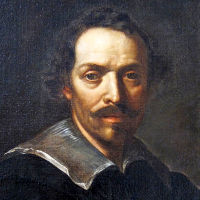 |
Pietro da Cortona, 1596–1669. Italian painter and architect.
A notable master of the Roman Baroque style, known especially for his religious subjects, Cortona also worked elsewhere, in such secular projects as his frescos of the Four Ages in the Pitti Palace in Florence.
|
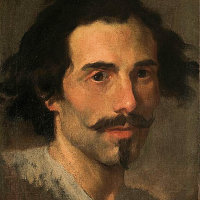 |
Gianlorenzo Bernini, 1598–1680. Italian sculptor and architect.
He is to the Italian Baroque what Michelangelo was to the Renaissance, the supreme master of many arts. The sense of movement and drama in his sculpture carries through into his architecture and even his town planning, such as the piazza before St. Peter's.
|
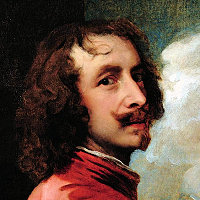 |
Anthony Van Dyck, 1599–1641. Flemish painter.
For a time the principal assistant to Peter Paul Rubens, Van Dyck had a shorter but similarly stellar and varied career, painting in most of the major baroque genres. He was especially known as a portraitist, particularly in England, where he served the courts of both James I and Charles I.
|
 |
Diego Velázquez, 1599–1660. Spanish painter.
Velázquez was the great master of the Spanish baroque, and with Rubens and Rembrandt, one of the giants of his century. He had been appointed court painter in 1624, at the age of only 25, with the exclusive right to paint the royal family. His historical, mythological, and genre scenes show an increasingly intricate imagination, especially as concerns the relationship of the painter to his work.
|
 |
Pierfrancesco Cavalli, 1602–76. Italian composer.
The leading opera composer after Monteverdi, his works dominated the Venetian stage in the mid 1600s, and frequently addressed mythological subjects, such as his La Calisto (1651).
|
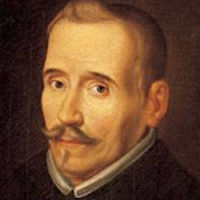 |
Juan Hidalgo de Polanco, 1614–85. Spanish composer.
He is considered the founder of Spanish opera and the more popular zarzuela. Wikipedia notes, "Juan Hidalgo dominated secular and theatrical music at the Spanish court until his death. He was a prolific composer and enjoyed a great deal of popularity throughout his career. His place in Spanish theatre history is equivalent to that of Purcell in Britain and Lully in France." [The portrait may not be him.]
|
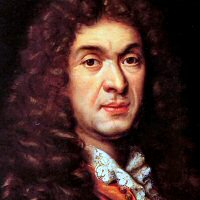 |
Jean Baptiste Lully, 1632–87. French composer of Italian origin.
Lully became master of music to Louis XIV, writing music in all genres, but most especially operas and ballets. His operas include Alceste (1675), Atys (1676), Persée (1682), and Armide (1686).
|
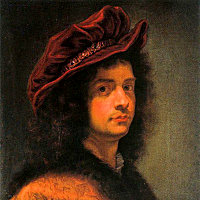 |
Giovanni Battista Gaulli, 1639–1709. Italian painter.
Coming to Rome in his early twenties, he was championed by Bernini, who helped him get his first major commission, the ceiling of the Jesuit mother church, the Gesù (1674–9). He also painted the official portraits of seven Popes. Sometimes known as "Baciccio."
|
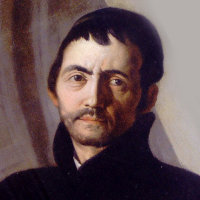 |
Fra Andrea Pozzo, 1642–1709. Italian painter.
A Jesuit lay brother, he is most famous for his masterpiece, the ceiling fresco in Sant'Ignazio in Rome, perhaps the most stupendous feat of illusionistic painting ever accomplished. He also workedin several other cities, and published a treatise on architectural painting which was widely influential.
|
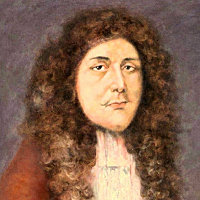 |
Heinrich Ignaz Franz Biber, 1644–1704. Bohemian-Austrian composer.
Biber worked in Bohemia and Eastern Austria before settling in Salzburg at the age of 26, where he remained for the rest of his life. A virtuoso violinist, he wrote some of the earliest solo pieces for the instrument. His sacred music includes the Missa Salzburgensis (1682) for 53 vocal and instrumental parts, the largest work ever composed in the baroque ear.
|













































